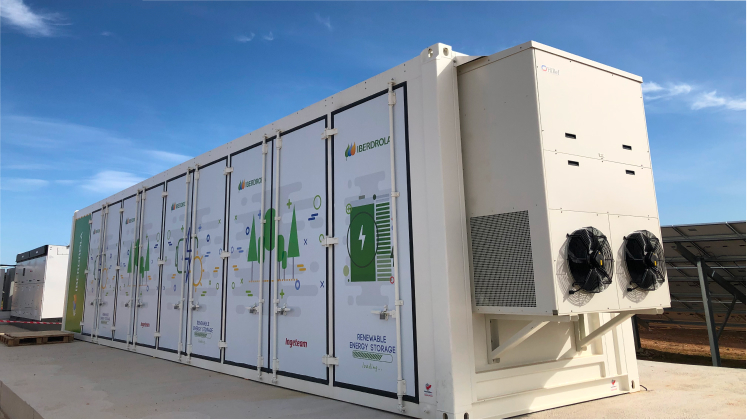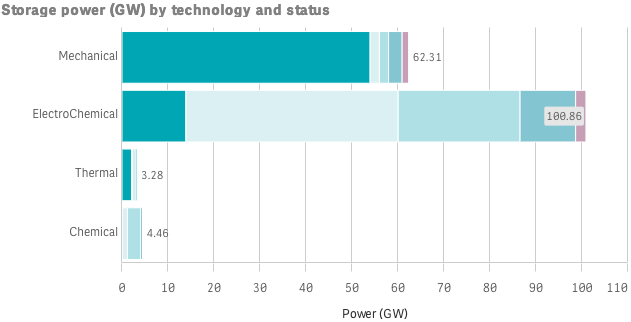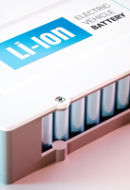Discover what thermal energy storage systems are and all their types.
Energy storage: batteries vs. thermal
The strategic importance of energy storage
The success of decarbonisation and the transition to mostly or totally consuming renewable energies depends on their stability throughout the day. Green energy production, as well as its storage, must be optimised to control how it is fed into the electricity grid and prevent issues due to its intermittency. This is where energy storage solutions such as BESS (Battery Energy Storage System) or thermal storage come into play, the combined use of which will help to renew the current grid to ensure mostly clean energy is being used.

The production and use of sustainably generated energy has become a necessity in recent decades. The exponential use of electricity (industrially, commercially, and residentially) has forced us to resort to sources that take advantage of natural and inexhaustible resources, such as sunlight and the wind, and don’t emit greenhouse gases into the atmosphere to meet demand.
However, this energy transition has been marked by the availability of these natural resources. To continue with the example, without those rays of sunshine or the force of the wind available 24 hours a day, production would come to a standstill. This has posed a challenge that the entire energy sector has thrown itself into solving to guarantee the best supply: energy storage.
The growing need for energy storage
Today, energy dependence is significant throughout the world. Any power cut or supply problem, especially if prolonged, has a direct impact on the economy and people's lives. To ensure the normal operation of critical infrastructure, industry, commercial spaces, homes and offices, strategies to provide this power must be developed.
Such is the importance of having this storage and knowing exactly what energy is currently available that the European Union has launched a project to monitor it in real time: the European Energy Storage Inventory.
This initiative highlights the need for smart systems that report information in real time. This controls and regulates the energy mix and provides information on its capacity in the event of a grid failure. The most widespread technologies today are electro-chemical, in the form of batteries, and mechanical, with water pumping, compressed air and flywheel systems. Others such as thermal storage and chemical storage are advancing daily.
The development of new methods of electrical energy storage is crucial to achieving this resilience in the global energy system. Seeking efficiency and working on more scalable solutions for current technologies is also on the sector's roadmap.

Contribution to grid stability and resilience
The electricity grid system operates on the basis of two main sources: fossil fuels and renewable energies. The former have been the main source of energy for many years, but their use brings with it two key problems: air pollution due to the constant emission of CO2 into the atmosphere and the use of finite raw materials that are highly subject to geopolitical developments. Green energy, on the other hand, is on the rise as it is a less polluting but more intermittent form of production. This is where the use of batteries has changed the rules of the game.
Maximising the potential of renewable energy
The International Energy Agency (IEA) predicts that installed storage capacity will increase significantly over the next few years, exceeding 270 GW by 2026. The European Commission has predicted two important milestones in renewable energy storage through various studies: 200 GW by 2030 and 600 GW by 2050.
With these objectives on the horizon, the market is striving to find alternatives to the mainstream energy storage system: pumped hydro. Although it’s an alternative that can store energy for several days, rather than just covering a few hours' needs, it has limitations due to the complicated infrastructure involved and the geographical dependence on large bodies of water.
This is where other models and technologies come into play. One of the most common methods is batteries, especially lithium-ion ones, which have become popular because of their versatility, with applications ranging from electronic devices and electric cars to larger, more complex systems that cover large facilities’ high energy demands. The energy density they can accumulate, the raw materials used to manufacture them (in addition to lithium-ion batteries, there are also sodium-sulphur, lead and vanadium batteries), and their modularity make them excellent candidates.
Thermal storage, which works with different materials such as molten salts, sand or ice stands out because it can store large amounts of heat energy. And although there is tech that can convert heat to electricity, its most efficient use is in the conservation and subsequent utilisation of that heat.

Lithium-ion batteries
The future of electrification requires energy storage, and lithium batteries are among the most widespread solutions.

Advances in storage
Changes in the way we produce and consume energy are driving innovation in grids and energy storage.

Heat Networks
District heating and cooling networks are responsible for supplying thermal energy to multiple users, including residential, tertiary and even industrial buildings.
Battery energy storage systems (BESS): flexible energy on demand
Below, we’ll discuss more about two of the ways to store power produced by renewable sources. We’ll begin with storing electrical power in batteries.
Battery Energy Storage Systems (BESS) are a technology that is already helping to optimise renewable energy. As the name suggests, it’s a system that consists of different pieces in addition to the battery itself to fulfill its main function: to store energy and fed it quickly into the grid in the form of electricity for use.
Both hardware and software come into play in BESS systems to intelligently control the entire process.
- Batteries: these are the basis of the entire system, the point at which all the energy is stored, and there can be two types of them:
- they generally use lithium-ion technology due to its reliability, solid performance and competitive price point,
- but they can also be built with flow batteries, which are easily recyclable, safe and have a lifespan of approximately 20 years.
- Battery management system (BMS): it controls the state of charge and discharge, as well as monitoring aspects such as temperature and life cycle.
- Power conversion system (PCS): it transforms the stored energy (direct current) into the form used by the grid (alternating current).
- Energy management system (EMS): it coordinates all these components, determines when to store and when to release energy, and ensures that everything works safely and efficiently.
A BESS: what it is and it’s made of
A Battery Energy Storage System (BESS) plays a crucial role in stabilising electricity grids, helping to include renewable energies and improving energy efficiency. These are its main parts.
Batteries
This is the main component of these systems, where energy is stored. They are made up of several elements.
Power Conversin System (PCS)
These are devices that convert the direct current (DC) stored in batteries to alternating current (AC) for use by the grid or end consumers.
Electricity grid

Renewable sources
An energy storage system can be combined with renewable sources to store energy without compromising stability from unplanned fluctuations in electricity generation.

Energy Management System (EMS)
The core of the system, responsible for monitoring and managing the power flow between the equipment and the batteries. It coordinates the work between the different BMS, PCS and other auxiliary components.

 SEE INFOGRAPHIC: A BESS: what it is and it’s made of [PDF]
SEE INFOGRAPHIC: A BESS: what it is and it’s made of [PDF]
Advantages to battery storage
Beyond being able to store surplus energy produced with renewable sources and integrate it efficiently into the grid, using batteries has some other advantages that make it a strong alternative for the transition that is currently underway.
- Ability to act as power islands. Some batteries are connected to energy production systems such as solar or wind power, but others, known as stand-alone power systems, can operate independently. This means they can provide energy independently.
- Flexibility and modularity. The very nature of this system facilitates modularity and flexibility at the location of those infrastructures that don’t have other options.
- Autogenous start-up. Although no progress has been made in the durability of stored energy, one of its competitive advantages is its immediate availability as an energy source in the event of any incident without the need for an external boost.
- Large storage capacity in a small space. They are easy to adapt to different environments.
Main applications for BESS batteries
To better understand the common uses of BESS, it’s useful to segment them by market applications and storable energy. This clearly differentiates the main uses for the technology:
- FTM (front-of-the-meter) applications, which typically exceed 10 MWh and are associated with public service facilities such as green energy production plants or critical infrastructure.
- BTM (behind-the-meter) applications in C&I. In the industrial sector, they have systems ranging from 10 MWh to 30 kWh, depending on each facility’s needs.
- BTM applications for residential use, which are usually less than 30 kWh to store power generated by photovoltaic installations for self-consumption or to power electric vehicle charging infrastructure.
These types of batteries can also be integrated into microgrids to distribute and supply power to more remote and difficult-to-access places.
Applications of BESS batteries
Front of the meter (FTM)
Public services
>10 MWh
- Storage and distribution of excess energy generated
- Price regulation
- Ancillary markets
Behind the meter (BTM)
Commerce and industry (C&I)
<10 MWh - > 30 kWh
- Adoption of photovoltaics for self-consumption
- Fast and uninterrupted power supply
- Energy cost savings
- Infrastructure for electric car charging points
Residential
< 30 kWh
- Adoption of photovoltaics for self-consumption
- Energy cost savings
- Infrastructure for electric car charging points
 SEE INFOGRAPHIC: Application of BESS batteries [PDF]
SEE INFOGRAPHIC: Application of BESS batteries [PDF]
Thermal energy storage: understanding the basics
One option that is growing in the market is thermal energy storage (TES). This technology is centuries old, with everyday examples of its application including cold storage in ice or even braziers and water heaters. However, applying it on a large scale and adapting it to current energy needs has required arduous research and development work, which is still ongoing. Now it allows geothermal and solar energy, as well as industrial or low-quality waste heat, to be stored to generate electricity and regulate temperature (heating, cooling, etc.) through more complex systems that can operate in large-scale projects.
What is thermal energy?
It is the energy generated through the random movement of molecules and atoms. The greater the movement, the more thermal energy is generated. This heat can be transferred three ways: conduction, convection, and radiation.
How is it stored?
Thermal energy storage captures heat or cold, stores it and releases it to generate similar or electrical energy. In addition to water at different temperatures, this is done using special materials, such as phase change materials, which conserve and release energy during this transformation. This technology allows large amounts of energy to be stored for long periods of time, making a significant contribution to the efficiency and advancement of sustainable energy.
Types of thermal energy storage
Although applications of this type of storage are centuries old, it has always been used to release the same type of energy it contained: heat or cold. The complexity of implementing it, especially in large projects, arises when instead of seeking to utilise that residual heat, it needs to be transformed into electricity. Here is where the technology needs more time and investment to mature properly. However, advances are being made and there are already several types of thermal energy storage:
- Sensitive heat storage (SHS): stores heat in materials such as water or molten salts, widely used in solar thermal plants. Here, the change in temperature in these materials reflects the amount of energy stored.
- Latent heat storage (LHS): uses materials that absorb and release energy through a phase change, from solid to liquid, for example.
- Thermo-chemical heat storage (TCHS): its operation is based on reversible chemical reactions that store or release heat.
We can also divide them accord by their operating temperature:
- Low: from sub-zero temperatures to approximately 100°C. A representative example of this type is aquifers for storing hot water.
- Medium: around 300°C.
- High: storing up to 1,000°C. Molten salt tanks, like those containing a mixture of sodium and potassium nitrate, whose usual operating range is between 285-565°C.
Materials used in thermal storage
Water is one of the raw materials that has been used for the longest time for thermal storage (both cold and hot). However, molten salts are one of the most common materials for large-scale applications thanks to their availability and ease of recycling.
There are also projects that use sand, stones, concrete or ceramics for their heat absorption and release properties. Research into the use of thermo-chemical materials is also on the rise, as they are expected to increase energy densities tenfold, according to CIC EnergiGUNE.
Advantages to thermal storage
Using this type of storage has many advantages when it comes to expanding the use of sustainably generated energy. And although not as widespread a technology as batteries or mechanical storage, the market is investing in its development because:
- Like all energy storage systems, it reduces dependence on fossil fuels and contributes to the better performance and stability of the electricity grid.
- It reduces industry’s operating costs. By harnessing waste heat and reusing it, energy costs are reduced.
- It can store energy for long periods of time.
- It’s versatile. It can store energy in the form of heat for later use or convert it into electricity.
- Highly scalable and adaptable, especially in large-scale projects.
- The initial investment is high, but the operating cost is low, especially when using molten salts or latent storage.
Main uses of thermal storage
Given this technology’s still immature implementation, its uses are not yet widespread. However, the most common use in storing renewable energy production is to place the heat generated in solar thermal power plants, especially by using molten salts.
Water-based storage systems can be used as heating systems for buildings, homes and residential areas, and for domestic hot water. This is the most widespread use of this technology because the heat delivery efficiency is very high, higher than if a battery were used.
Although it is not used to store surplus renewable energy, there are applications of this type of technology for building insulation, which contributes to indoor temperature regulation and, with it, energy savings.
From an optimisation perspective, using thermal storage to use and release heat is the most advisable. This is because current technology has not managed to prevent most of the stored energy from being lost: it only efficiently converts 30 to 40% of that heat energy into electricity.
Batteries vs. thermal storage: a comparative analysis
Although these two technologies have similar advantages, their applications may vary. Batteries or BESS systems are more technologically advanced and more widely used in renewable energy, but their use has limitations. Maintenance costs, maximum storage capacity and life cycle, combined with the complexity of manufacturing and recycling batteries, are hampering their growth.
Thermal storage is very promising for storing heat energy, but the market is not yet mature enough. However, it has enormous potential due to its scalability, modularity, low maintenance and durability.
TES vs BESS
Use and versatility
TES
High: harnesses heat energy, which can be maintained as-is or converted into electricity./p>
BESS
Low: exclusively uses electrical power
Energy density
TES
Varies depending on the tech used in the project
BESS
High
Cost
TES
High initial investment, but medium to low operating costs
BESS
Moderate or high initial investment, depending on the project size. Moderate maintenance costs due to battery degradation
Scalability
TES
High: especially in large industrial projects and solar plants
BESS
Medium: suitable for domestic or grid scales with technological limitations
Efficiency
TES
High when releasing heat, low when converting to electricity
BESS
High: notable for its rapid availability
Storage
TES
High: varies from days to weeks depending on the technology used
BESS
Medium-low: ideal for hours of supply
Maturity level
TES
Medium: rapidly developing technology, but low market adoption
BESS
Medium-high: technology widely introduced into the market
Environmental impact
TES
Low if easily recyclable materials are chosen
BESS
Medium due to mining for materials such as lithium. Hard to recycle
The fundamental distinction: electricity vs. heat
The main difference between these two types of storage lies in the type of energy they can store. This is not the case with the energy they can release, which in both cases can be electrical.
BESS management is limited exclusively to the storage, conservation and release of electrical power. That means this is the main characteristic to take into account when incorporating them into a project.
Thermal energy storage, on the other hand, uses heat to conserve and subsequently produce heat or electricity as needed. This characteristic will dictate its use in energy saving and utilisation projects. Here, the efficiency offered is very different: conversion to electricity is 30 to 40%, however, when the cold or heat stored in this form is released, its utilisation is almost total.
Suitability for different needs: when to choose each solution
Heating a building, storing excess solar energy generated on a sunny day, using the heat generated in a factory, charging an electric car... There are thousands of use cases, each with its own particular needs. This is where the specific characteristics of each energy storage option become important.
If you’re looking for speed and independence
Batteries make rapid response to any energy need possible and can operate without being connected to any other system. Their universality makes them modular and suitable for installation in a variety of environments.
If you need to store thermal energy
The only option available is thermal energy storage, which allows you to capture that heat and store it for later use or convert it into electrical energy.
If you need it to be scalable, but in a cost-efficient way
Thermal storage systems are easily scalable and flexible because their capacity can be increased by adding the chosen raw material in an economical way. Increasing the capacity of an already installed battery, on the other hand, can be more expensive.
If you need efficiency
Batteries are more efficient when it comes to using electrical energy. In the case of thermal energy, 60–70% of energy is lost during the conversion from heat to electricity. However, if you need to store and release heat, thermal storage is the best option.
If you have a large industrial project
Both options are possible. There are batteries that store large amounts of energy in different wind and photovoltaic plants, as well as thermal storage using molten salts or latent or thermo-chemical heat systems. In the case of the latter, they can store large amounts of energy and release it over a longer period of time, which, added to their scalability, makes them a very attractive option from a cost point of view. However, batteries can provide an uninterrupted current.
The future of energy storage: towards a synergistic approach
Technology is advancing every day, studying different possibilities to optimise the adoption of renewable energies and increase their penetration in the energy mix. But this investment in research and development is not being made to consolidate just one technology; all of them have a place in the present and future of energy consumption.
A good understanding of the characteristics and vulnerabilities of each of them will make it easier to choose the best ones for each project. This will create a scenario in which, to achieve the energy transition, coexistence is not only possible but necessary. A synergistic approach to choosing the best energy storage is the only way to take firm steps towards a more sustainable future.












